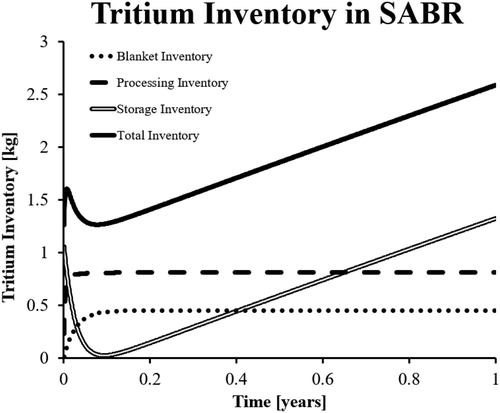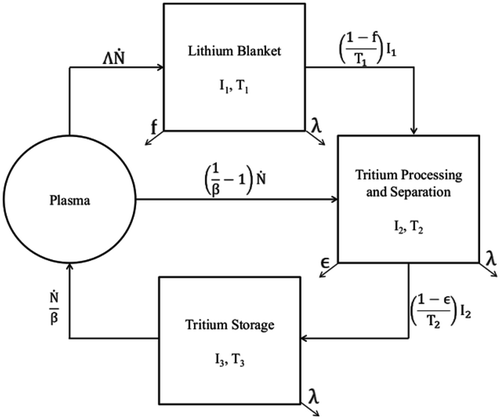W. M. STACEY et al., “Resolution of Fission and Fusion Technology Integration Issues: An Upgraded Design Concept for the Subcritical Advanced Burner Reactor,” Nucl. Technol., 187, 15 (2014); http://dx.doi.org/10.13182/NT13-96.
The authors have noticed a mistake in the tritium breeding calculation in Sec. V.D of the paper. There were two mistakes made in the original subcritical advanced burner reactor (SABR) tritium breeding ratio (TBR) analysis done in 2014. One was a typo in EquationEq. (5)(5) and had no impact on the results, but the other was an error in the calculation that does impact the results, but not to a large extent. The exact values of quantities such as the initial tritium inventory and required doubling time are slightly different, but the primary results that a SABR reactor would be tritium self-sufficient and be able to withstand (1) a 90-day shutdown after 1 year of operation and (2) a 2-day unexpected maintenance period in the tritium reprocessing system are still correct.
Section V.D is reproduced here as follows, but with the necessary modifications to correct the errors.
V.D. Tritium Recovery and Self-Sufficiency
The value of the TBR is a preliminary check of the SABR capability to produce more tritium than it consumes. However, the time dependency of the tritium inventory must be examined to ensure that small unplanned outages of processing systems and large planned shutdowns can be tolerated. Previous analysis56 has defined general analytical models to determine the tritium inventory in plasma fusion reactor systems. The SABR system model has been simplified to that shown in with model parameters defined in .
TABLE XII Tritium Inventory Model Parameters
Once the fuel cycle is determined, the time-dependent fusion neutron source requirement will be known and can be used in the calculation. For now, we estimate based on past experience that the average fusion power level over the first year would be ∼260 MW and carry out the inventory calculation at this fixed fusion power level over the year.
EquationEquations (5)(5) describe the tritium inventory for the blanket, I1, the processing system, I2, and the storage containment, I3. The requirement for the initial inventory in storage to start the fusion reactor was determined by the constraint that I3 > 0:
and
(5)
Solutions to EquationEqs. (5)(5) with zero initial tritium concentration for the blanket and the processing system are shown in . With these parameters, the tritium doubling time for the system is ∼591 days, and the reactor regains the initial inventory amount I0 again in the storage containment in 308 days. If the reactor runs for 1 year and shuts down for refueling for 90 days, there will be ∼2.59 kg left, which is enough to restart the reactor with the requirement of 1.1 kg.
Fig. 14. Tritium inventories in the blanket, processing systems, and storage containment for 1 year after startup.

The above modeling is more simplistic than in Ref. 53 because plasma exhaust, tritium breeding blanket, tritium breeding blanket coolant, first-wall coolant, and cleanup and separation processing units are lumped into one processing compartment with a composite residence time. During operation, any one of these compartments may be shut down for maintenance, requiring a minimum tritium inventory Imin in the storage vessel such that the reactor can continue operation. This minimum inventory depends most on the plasma fueling rate and fractional tritium burnup in the plasma. Since SABR burns ∼15 kg T/year, the minimum inventory was calculated to be ∼1.6 kg of tritium for a 2-day processing system shutdown. The minimum inventory is a reserve for the processing systems and should be taken into account with the initial condition for startup of the reactor, but ex post facto inclusion of this minimum amount to the initial storage containment condition did not have significant effect on analysis, except for the doubling time because of the larger total inventory. Therefore, the total tritium required in storage to allow a 2-day unexpected maintenance shutdown is the superimposition of the initial inventory required for startup determined by solving EquationEq. (5)(5) (1.1 kg) and the minimum requirement from the fueling rate (1.6 kg), which is calculated to be 2.7 kg total.

